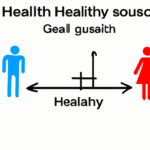Healthcare inequality is a systemic issue rooted in various causes. Socioeconomic status plays a significant role, as individuals with lower income levels often encounter barriers to accessing quality healthcare services. Limited access to healthcare facilities, health insurance, and high healthcare costs contribute to disparities in healthcare outcomes. Discrimination based on factors such as race, ethnicity, gender, or disability also perpetuates inequality. Inadequate healthcare infrastructure and resources in underserved communities further exacerbate inequities. Additionally, cultural and linguistic barriers, as well as educational disparities, create significant challenges in seeking and understanding healthcare information. Addressing these root causes is crucial for ensuring equal access to healthcare services for all individuals.
One of the main causes of healthcare inequality is socio-economic status. People from lower income brackets often face barriers to accessing quality healthcare. Limited financial resources can lead to inadequate health insurance coverage or the inability to afford necessary treatments and medications. This results in disparities in healthcare outcomes between the poor and the wealthy.
Geographical location plays another significant role in healthcare inequality. Rural areas, in particular, have fewer healthcare resources compared to urban areas. Limited availability of hospitals, clinics, and specialized medical professionals can impede access to timely and quality healthcare for those living in remote or underserved regions.
Another cause of healthcare inequality is systemic discrimination. Marginalized communities such as racial or ethnic minorities, LGBTQ+ individuals, and people with disabilities often face discrimination within healthcare systems. This can manifest as biased treatment decisions, unequal access to healthcare facilities, longer wait times, and inadequate provision of services.
Unequal distribution of healthcare providers is also a contributing factor. In many countries, healthcare professionals tend to concentrate in urban centers, making it difficult for individuals living in rural or disadvantaged areas to access the same level of care as urban dwellers. This maldistribution of healthcare resources exacerbates healthcare inequalities.
Furthermore, lack of health literacy and education is another cause of healthcare inequality. Insufficient knowledge about health conditions, preventive measures, and available resources can limit individuals’ ability to make informed health decisions. This lack of understanding can result in delayed treatment or inappropriate self-care, perpetuating health disparities in the population.
Overall, healthcare inequality arises from multiple interrelated factors, including socio-economic disparities, geographical location, systemic discrimination, unequal distribution of healthcare resources, and limited health literacy. Addressing these causes is essential to reduce disparities and ensure equitable access to healthcare for all individuals.
Socioeconomic status
Socioeconomic status (SES) is a multidimensional concept that encompasses an individual’s or a community’s economic and social position in society. It is determined by various factors, including income, education level, occupation, and social prestige. SES plays a significant role in healthcare inequality, as it directly impacts an individual’s access to quality healthcare services and overall health outcomes.
Income is one of the key components of SES. People with higher incomes are generally more likely to afford healthcare services, health insurance, and necessary medications. This financial stability allows them to have better access to healthcare facilities and providers, which often translates into more timely and appropriate care. On the other hand, individuals with lower incomes face financial barriers that can prevent them from seeking necessary medical attention, resulting in delayed or inadequate healthcare.
Education level is another determinant of SES that strongly influences healthcare inequality. People with higher educational attainment tend to have better health literacy, enabling them to understand health-related information, make informed decisions, and navigate the complex healthcare system effectively. Moreover, higher education levels can provide individuals with access to higher-paying occupations that offer comprehensive health insurance coverage. In contrast, individuals with lower education levels may face limited health literacy, leading to difficulties in understanding medical instructions, preventive measures, and treatment options.
Occupation is closely linked to both income and education level and is a crucial factor shaping SES and healthcare inequality. Many occupations offer comprehensive health insurance coverage as part of their benefits package, ensuring that employees have access to healthcare services. However, individuals in low-paying jobs or those without access to employer-sponsored health insurance may struggle to afford medical expenses, resulting in disparities in healthcare access and outcomes.
Social prestige, often measured by factors such as social standing, occupation status, and recognition in the community, can also impact healthcare inequality. Individuals with higher social prestige are more likely to have access to higher-quality healthcare facilities and providers, as well as greater social support and resources. Conversely, those with lower social prestige may face barriers in accessing appropriate healthcare due to limited resources and lack of social support networks.
In conclusion, socioeconomic status is a critical determinant of healthcare inequality. Income, education level, occupation, and social prestige collectively shape an individual’s or a community’s access to quality healthcare services and ultimately influence their health outcomes. Acknowledging these disparities and addressing the root causes of healthcare inequality is crucial to ensure that everyone has equitable access to healthcare and the opportunity to achieve optimal health.
racial disparities
Racial disparities in healthcare refer to the unequal treatment and outcomes experienced by individuals from different racial and ethnic backgrounds within the healthcare system. These disparities manifest in various aspects of healthcare, such as access to healthcare services, quality of care received, and health outcomes.
One key aspect of racial disparities in healthcare is the unequal access to healthcare services. Research consistently shows that certain racial and ethnic groups face barriers that limit their ability to access healthcare, including a lack of health insurance, limited availability of healthcare facilities in their communities, and transportation challenges. These barriers result in delayed or forgone medical care, contributing to health disparities among different racial groups.
Additionally, racial disparities are evident in the quality of care provided to different racial and ethnic groups. Studies have demonstrated that minority patients often receive lower-quality care compared to their white counterparts, even when controlling for factors such as insurance status and income. This discrepancy in the quality of care can be attributed to various factors, including implicit bias, cultural insensitivity, and systemic inequalities.
Furthermore, racial disparities in healthcare are reflected in health outcomes. Individuals from racial and ethnic minority groups often experience worse health outcomes, including higher rates of chronic diseases, mortality, and certain health conditions. For example, African Americans have higher rates of hypertension, diabetes, and certain types of cancer compared to white Americans. These discrepancies may be influenced by a combination of socioeconomic factors, unequal access to preventive care, and systemic racism within the healthcare system.
It is crucial to recognize and address racial disparities in healthcare as they have significant implications for public health and social justice. Health equity requires ensuring that all individuals, regardless of their race or ethnicity, have equal opportunities and resources to access quality healthcare services. Efforts to reduce racial disparities in healthcare involve implementing policies to expand healthcare coverage, promoting cultural competence and diversity in the healthcare workforce, and implementing strategies to address implicit bias and discrimination within the healthcare system.
Addressing racial disparities in healthcare is not only a matter of fairness and justice but also an important step towards improving overall population health. By providing equitable healthcare services, we can work towards eliminating racial disparities and achieving better health outcomes for everyone, regardless of their racial or ethnic background.
geographic location
Geographic location plays a significant role in healthcare inequality. The distribution of healthcare resources and facilities can vary greatly based on where individuals reside. This discrepancy can result in unequal access to quality healthcare, leading to disparities in health outcomes between different geographic locations.
In rural areas, for instance, the availability of healthcare services may be limited compared to urban areas. Sparse populations, long distances, and underdeveloped infrastructure can all contribute to reduced access to healthcare facilities and professionals. Rural communities often struggle to attract and retain healthcare providers, leading to a shortage of doctors, specialists, and other healthcare professionals. As a result, individuals living in rural areas may face challenges in receiving timely and comprehensive healthcare services.
Moreover, geographic location can also influence the availability of specialized medical services. Urban areas tend to have a higher concentration of hospitals and medical centers, ensuring residents have access to a wide range of healthcare services. These urban areas often have specialized facilities equipped with advanced medical technologies and a greater number of specialized healthcare professionals. This allows individuals living in urban areas to receive specialized treatments and access to cutting-edge medical advancements which may not be available in rural locations.
Additionally, the impact of geographic location on healthcare inequality extends to healthcare infrastructure. Inadequate infrastructure can hinder the delivery of healthcare services, especially in remote areas. Limited or substandard road networks, transportation systems, and communication channels make it difficult for individuals to access healthcare facilities in a timely manner. Lack of proper infrastructure can also affect emergency response times, making it challenging for individuals residing in certain locations to receive immediate medical attention during critical situations.
Furthermore, environmental factors influenced by geographic location can play a role in healthcare disparities. Some areas may be prone to natural disasters, such as floods, earthquakes, or hurricanes, which can disrupt healthcare services and infrastructure. Individuals living in these regions may face greater barriers in accessing healthcare during and after such disasters, leading to increased health risks and further widening the gap in healthcare inequality.
In conclusion, geographic location profoundly influences healthcare inequality. Disparities in access to healthcare services, shortage of healthcare professionals, uneven distribution of specialized medical services, lack of infrastructure, and environmental factors all contribute to this inequality. Addressing the healthcare disparities caused by geographic location requires efforts to improve healthcare infrastructure, attract healthcare professionals to underserved areas, and invest in telemedicine and other solutions that can bridge the gap between urban and rural healthcare access.
access to healthcare resources
Access to healthcare resources refers to the availability and utilization of essential healthcare services, facilities, and professionals by individuals and communities. It plays a crucial role in determining the level of healthcare inequality experienced within a society. Unequal access to healthcare resources is a significant contributor to disparities in health outcomes, particularly among marginalized populations.
One factor that affects access to healthcare resources is geographical location. Rural areas often face challenges in terms of availability and proximity to healthcare facilities, forcing individuals to travel long distances to access necessary care. Inadequate transportation infrastructure further exacerbates the problem, making it difficult for individuals in remote areas to reach healthcare centers in a timely manner. This geographic disparity disproportionately affects individuals of lower socioeconomic status who may not have the means to travel long distances or relocate closer to healthcare facilities.
Another aspect of access to healthcare resources is the availability of healthcare facilities and providers in an area. In areas with a shortage of healthcare professionals, individuals may experience long wait times, limited appointment availability, and reduced access to specialized care. This issue is particularly prevalent in low-income communities, where there is often a lack of healthcare facilities due to financial constraints or unavailability of qualified healthcare professionals. The scarcity of resources in these areas further perpetuates healthcare inequality.
Socioeconomic factors also play a crucial role in determining access to healthcare resources. Individuals with lower incomes may face financial barriers in accessing healthcare services, such as high out-of-pocket costs, limited health insurance coverage, or lack of access to preventive care. Limited financial resources can lead to delays in seeking necessary healthcare, resulting in worsened health outcomes and increased healthcare inequality. Additionally, individuals from low-income backgrounds may also face language and cultural barriers, further impeding their access to healthcare services.
Furthermore, discrimination and inequitable distribution of healthcare resources based on factors such as race, ethnicity, gender, and age also contribute to healthcare inequality. Historically marginalized populations may experience reduced access to quality healthcare due to systemic biases and prejudice within the healthcare system. This includes limited availability of culturally appropriate care, discriminatory practices, and implicit biases among healthcare providers that hinder equitable access to healthcare resources.
Addressing healthcare inequality requires a multifaceted approach that involves increasing the availability and distribution of healthcare resources. This includes strategies such as investment in healthcare infrastructure in underserved areas, encouraging healthcare professionals to practice in these areas through financial incentives or loan forgiveness programs, and expanding health insurance coverage to ensure affordability and reduce financial barriers. Additionally, efforts to promote cultural competency and diversity among healthcare providers can help ensure equitable access to care for all individuals, regardless of their background or socioeconomic status.
In conclusion, access to healthcare resources is a critical factor in determining healthcare inequality. Geographical location, availability of healthcare facilities and providers, socioeconomic factors, and discrimination all contribute to disparities in access to healthcare services. Addressing these issues requires a comprehensive approach that focuses on increasing the availability and distribution of healthcare resources, reducing financial barriers, and promoting cultural competency within the healthcare system.
and insurance coverage.
Insurance coverage is a significant factor contributing to healthcare inequality. The availability and affordability of insurance plans can determine an individual’s access to vital healthcare services. Lack of insurance coverage often leads to delayed or inadequate medical treatment, resulting in adverse health outcomes for those in need.
One of the primary reasons behind healthcare inequality related to insurance coverage is the high cost of insurance plans. Premiums, deductibles, and copayments can pose significant financial barriers for individuals with limited financial resources. As a result, these individuals may be unable to afford insurance coverage or may have to settle for plans with limited benefits and coverage. This lack of comprehensive coverage can limit their access to high-quality healthcare services and create disparities in healthcare outcomes.
In addition to cost, certain populations face unique challenges in obtaining insurance coverage. For example, individuals with pre-existing conditions often struggle to find affordable coverage, as insurance companies may either deny them coverage or charge prohibitively high premiums. This leaves these individuals without vital healthcare protection, exacerbating healthcare inequality in terms of access to necessary medical care.
Another factor contributing to healthcare inequality is the coverage gap that exists among different demographics. Low-income individuals, particularly those with limited access to employer-sponsored health insurance, often rely on government-funded programs such as Medicaid. However, not all states have expanded Medicaid eligibility as part of the Affordable Care Act, leaving many individuals without coverage options. Consequently, these individuals may not receive timely preventive care or early intervention for health issues, leading to poorer health outcomes.
Furthermore, access to insurance coverage is closely tied to employment for many individuals. Those working in low-wage jobs or part-time positions often do not have access to employer-sponsored health insurance, making it challenging for them to afford coverage independently. This results in a higher likelihood of being uninsured or underinsured, leading to delayed or inadequate healthcare services when needed.
Overall, insurance coverage plays a vital role in determining an individual’s access to healthcare services. The high cost of insurance plans, the barriers faced by individuals with pre-existing conditions, the coverage gap among different demographics, and the tie between insurance and employment are all factors that contribute to healthcare inequality. Addressing these issues is crucial to ensure equitable access to healthcare for all individuals, regardless of their socioeconomic status or health conditions.













